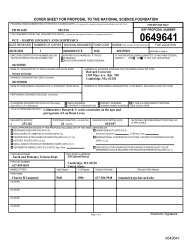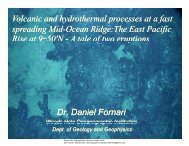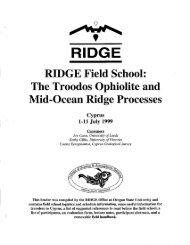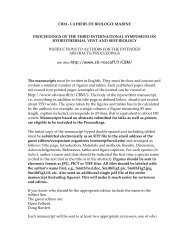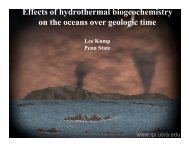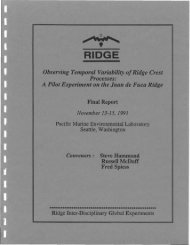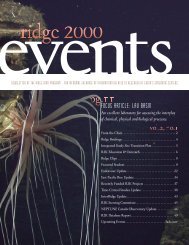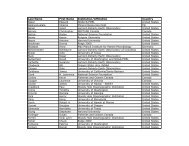Create successful ePaper yourself
Turn your PDF publications into a flip-book with our unique Google optimized e-Paper software.
and rough topography. We further require the development of<br />
forward numerical modelling and inverse methods appropriate when<br />
the heterogeneities are on the order of seismic wavelengths of<br />
200 to 500 m, and that also account for the effects of surface<br />
and volume scattering, attenuation, and anisotropy at these<br />
scales. The integrated analysis of swath mapping, acoustic<br />
imaging, multichannel profiling, and aero-gravity and magnetics<br />
data will require the development of an interactive computer<br />
imaging and data analysis capacity.<br />
Marine Data Acquisition<br />
Our ability to initiate the measurement and sampling<br />
programs discussed above rests on the fact that new techniques,<br />
some brought into play only recently, are available to gather<br />
many of the types of data we need. These include multibeam echo<br />
sounding systems, acoustic and optical imaging techniques, ocean<br />
bottom seismographs, magnetometers, shipboard and airborne<br />
gravimeters and methods for controlled sampling of loose rock.<br />
The rates of coverage and the resolution of existing versions of<br />
these systems, while adequate for some purposes, leave much room<br />
for improvements and specific ideas exist as to how such<br />
improvements could be made. Beyond these existing instrument<br />
types there are new concepts emerging that could contribute<br />
substantially to our understanding of the generation and<br />
evolution of the lithosphere, and that could be available within<br />
the next few years. These include devices for obtaining<br />
oriented, fresh rock samples from selected outcrops; systems for<br />
measuring strain, tilt and elevation changes; and high<br />
resolution on-bottom gravimeters.<br />
Two challenging areas for the future lie in implementing an<br />
ability to locate and react rapidly to the occurrence of<br />
transient events {volcanic eruptions, earthquakes}; and in<br />
developing means for using deep drill holes after departure of<br />
the drilling ship. Under-way monitoring of hydrothermal venting<br />
would allow us to detect hydrothermal activity while conducting<br />
large-scale surveys.<br />
In addition to the measurement instruments required for<br />
particular types of data acquisition, there are several recent<br />
supporting technological advances that will enhance our ability<br />
to carry out sea foor tasks effectively. Fiber optic cables,<br />
remote operated cable connected and autonomous vehicles,<br />
improved computing and recording capacity for shipboard and sea<br />
floor data handling, and continuous high-accuracy satellite<br />
navigation will all help open new opportunities.<br />
Finally, it is clear that this program embodies significant<br />
ship requirements supporting a wide range of capability. For<br />
global and regional surveys we will need the use of a ship with<br />
well integrated survey capabilities for extensive periods. This<br />
36




